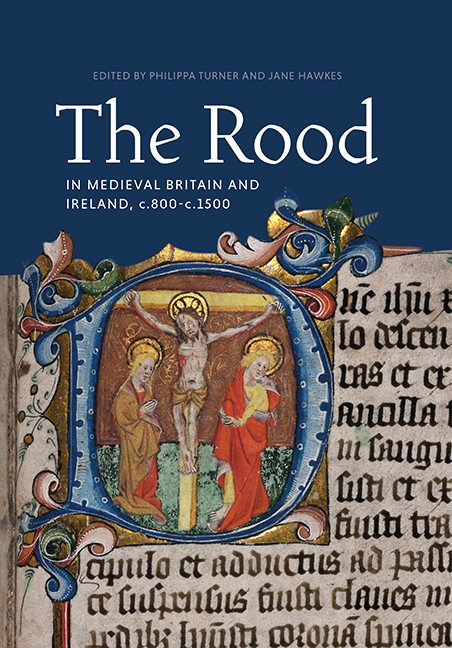Book contents
- Frontmatter
- Contents
- List of Illustrations
- List of Contributors
- Acknowledgements
- List of Abbreviations
- 1 Introduction: Rethinking the Rood
- 2 Approaching the Cross: The Sculpted High Crosses of Anglo-Saxon England
- 3 The Mark of Christ in Wood, Grass and Field: Open-Air Roods in Old English Medical Remedies
- 4 Twelfth-Century English Rood Visions: Some Iconographic Notes
- 5 Crosses, Croziers and the Crucifixion: Twelfth-Century Crosses in Ireland
- 6 From Religious Artefacts to Symbols of Identity: The Role of Stone Crosses in Galician National Discourse
- 7 The Rood in the Late Medieval English Cathedral: The Black Rood of Scotland Reassessed
- 8 The Cross of Death and the Tree of Life: Franciscan Ideologies in Late Medieval Ireland
- 9 Heralding the Rood: Colour Convention and Material Hierarchies on Late Medieval English Rood Screens
- 10 Reframing the Rood: Fifteenth-Century Angel Roofs and the Rood in East Anglia
- Bibliography
- Index
- Already Published
- Plate Section
10 - Reframing the Rood: Fifteenth-Century Angel Roofs and the Rood in East Anglia
Published online by Cambridge University Press: 07 November 2020
- Frontmatter
- Contents
- List of Illustrations
- List of Contributors
- Acknowledgements
- List of Abbreviations
- 1 Introduction: Rethinking the Rood
- 2 Approaching the Cross: The Sculpted High Crosses of Anglo-Saxon England
- 3 The Mark of Christ in Wood, Grass and Field: Open-Air Roods in Old English Medical Remedies
- 4 Twelfth-Century English Rood Visions: Some Iconographic Notes
- 5 Crosses, Croziers and the Crucifixion: Twelfth-Century Crosses in Ireland
- 6 From Religious Artefacts to Symbols of Identity: The Role of Stone Crosses in Galician National Discourse
- 7 The Rood in the Late Medieval English Cathedral: The Black Rood of Scotland Reassessed
- 8 The Cross of Death and the Tree of Life: Franciscan Ideologies in Late Medieval Ireland
- 9 Heralding the Rood: Colour Convention and Material Hierarchies on Late Medieval English Rood Screens
- 10 Reframing the Rood: Fifteenth-Century Angel Roofs and the Rood in East Anglia
- Bibliography
- Index
- Already Published
- Plate Section
Summary
This essay examines the material centrality of the sacrificial imagery of the rood at the east end of the fifteenth-century East Anglian church nave, in terms of its framing by carved roof angels. This association is recovered through the coincidence of material analysis and documentary evidence. Despite the eradication of the crucifix or rood group from parish churches, open timber roofs with angelic carvings represent remarkable survivals. The largest concentration of late medieval ‘angel roofs’ is found in East Anglian parish churches. Carved angels carrying a variety of attributes form, or are attached to, their beam-ends. Although some have suffered from iconoclasm, these roofs present a substantial body of previously untapped visual evidence for investigating the significance of angelic imagery in comprehensive representational schemes which often cover the entire nave and have the rood as their focus. Angels are ubiquitous in late medieval Christianity and its visual culture, yet their pervasive existence has often been neglected. Attending to the specificity of their presentation can indicate their function within the parish church. Studies have taken similar approaches to details of other late medieval parish church imagery; for example, Nichols’ discussion of the iconography of penance in East Anglian Seven Sacrament fonts, Baker's work on angelic screen paintings and Varnam's analysis of the relationship between medieval sermons and images in glass and wall paintings. The iconography of East Anglian roof carvings was often designed as a unified focus for a diverse and mobile lay audience, whose participation in the Mass was distinctive and socially important, and it is the intention of this discussion to address their particular agency in this. I contend that the imagery and form of these angelic compositions was deliberate and persuasive, enhanced and enlivened by a creative interaction with sermons and texts, arguing that their reception was active and social, reflecting a reciprocal relationship between image and viewer.
ICONOGRAPHY AND INTEGRATION: THE ROOD, THE DOOM, AND THE ROOF
This contention calls for a holistic approach and for the ‘framing’ of these carved figures, not only in terms of their interaction with human activity at ground level, but in relation to other aspects of the iconographic scheme of the parish church. In particular, this discussion will examine the visual relationships that would have existed between angelic roof programmes and the heavenly hierarchy visualised in the rood group, Doom paintings and on chancel screens.
- Type
- Chapter
- Information
- The Rood in Medieval Britain and Ireland, c.800-c.1500 , pp. 161 - 184Publisher: Boydell & BrewerPrint publication year: 2020



